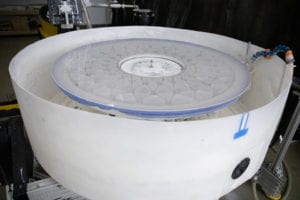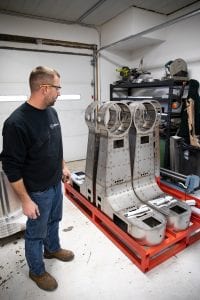Posted:
Optical Testing at PlaneWave
At PlaneWave, our observatory system testing is more rigorous, thorough, and intentional than any of our competitors. When we set out to create the perfect telescope, we found the testing processes, systems, and software that existed did not meet our high standards. PlaneWave has continually developed and refined our testing methods, instrumentation, and analytical software to ensure harmony between product, design, and performance. We have combined traditional, industry-standard practices with our proprietary tools and methods to allow detailed verification of manufacturing and assembly requirements while maintaining an efficiency that adds to PlaneWave’s product value.
Our indoor testing facilities offer a constant testing environment so we aren’t limited by visibility, location, or time of year to test our telescopes. Each mirror in our optical systems undergoes an extensive process of figuring, testing, and inspection to guarantee peak performance. During mechanical production, parts and sub-assemblies are inspected and tested throughout each step of the assembly process. Most importantly, we’re raising the bar by testing every element of our telescopes and mounts throughout every step of the assembly process to ensure the only thing standing between you and flawless observation is a cloudy sky.
Optical Testing
PlaneWave’s optical testing is inseparable from our optical production. Inside our climate and air-flow-controlled test environments, PlaneWave technicians use our proprietary metrology system to generate a detailed wavefront map for every mirror at each stage of our manufacturing process. The data is then uploaded to one of our state-of-the-art, robotic figuring machines which analyzes the surface profile of the mirror and makes corrections that deliver a surface accuracy of a fraction of a wavelength of light. This measurement and figuring process is repeated until each mirror meets the exacting quality required for every PlaneWave system.
While some telescope manufacturers outsource their mirror production and can only trust the test reporting from their vendor, PlaneWave maintains the ability to test each of our mirrors at every step of the fabrication process. Within the optics labs on our Michigan campus, we have built a vertical test tunnel for our largest optical systems, multiple horizontal test tunnels for our 12.5” to 24” optical systems, numerous vertical test systems for mirrors in polishing and figuring, match-plate inspection stations for convex mirror testing, and scratch inspection stations.
 After final figuring, our mirrors are coated, mounted in their support cells, and retested for wavefront error to ensure that deformation has not been introduced during these processes. The importance of this step cannot be understated: the wavefront error of an unmounted optic is nearly meaningless to the performance of an assembled system and many other optical system manufacturers skip this test or remove astigmatism and other errors from their measurements. At PlaneWave, we understand that these errors can be significantly detrimental to the performance of the complete system. We do not pass mirrors or final assemblies without verifying their resulting wavefront.
After final figuring, our mirrors are coated, mounted in their support cells, and retested for wavefront error to ensure that deformation has not been introduced during these processes. The importance of this step cannot be understated: the wavefront error of an unmounted optic is nearly meaningless to the performance of an assembled system and many other optical system manufacturers skip this test or remove astigmatism and other errors from their measurements. At PlaneWave, we understand that these errors can be significantly detrimental to the performance of the complete system. We do not pass mirrors or final assemblies without verifying their resulting wavefront.
In addition to testing each mirror throughout our manufacturing process, we test every one of our telescopes as a complete, finished system in one of our modern test tunnels. This ensures that each optical system is confirmed to be diffraction-limited before shipment. As our test tunnels are temperature and air-circulation-controlled, we can reduce atmospheric scintillation that impacts on-sky measurements, allowing for extremely precise measurements. This enables our expert technicians to efficiently identify and correct any residual alignment errors in the complete optical system. This final optical test is the ultimate guarantee that our telescopes will yield the excellent performance that our customers have come to expect.
Mount and Gimbal Testing
 Our telescope mounts are agile direct-drive tracking systems that achieve shocking accelerations and speeds while maintaining low jitter and stable tracking, even when moving at LEO tracking rates of several degrees per second. Our mounts have been engineered for high field performance and our assembly requires rigorous testing with precise standards to ensure they function flawlessly for our customers.
Our telescope mounts are agile direct-drive tracking systems that achieve shocking accelerations and speeds while maintaining low jitter and stable tracking, even when moving at LEO tracking rates of several degrees per second. Our mounts have been engineered for high field performance and our assembly requires rigorous testing with precise standards to ensure they function flawlessly for our customers.
PlaneWave manufactures nearly every part and component in our L-Series mounts and the larger mounts used for the CDK700, RC700, and PW1000. Machined parts are inspected both during production in our machining facilities and again upon delivery at our assembly facilities.
As the motor assembly begins, our technicians continually check for unexpected and unwanted resistance or eccentricity in the stack. Motor coils are tested for resistance and wire harnesses are checked for continuity. Then, final fit checks are performed as the motors are integrated into the mount structures and final electrical testing is conducted.
Our testing continues with extensive indoor performance testing for each mount. We run the L-350, L-500, and L-600 mounts through no less than 24 hours of automated slew testing while PlaneWave’s larger gimbals for the CDK700, RC700, and PW1000 undergo an even longer process. These tests measure slew rates, currents, and resistance to capture a full spectrum of data from the axis encoders. The resulting data reveals whether the system meets our demanding jitter and tracking accuracy standards. If a motor underperforms against any criteria, it is rebuilt and testing renews from the very beginning. It is the best way to be certain our mounts will meet or exceed your expectations.